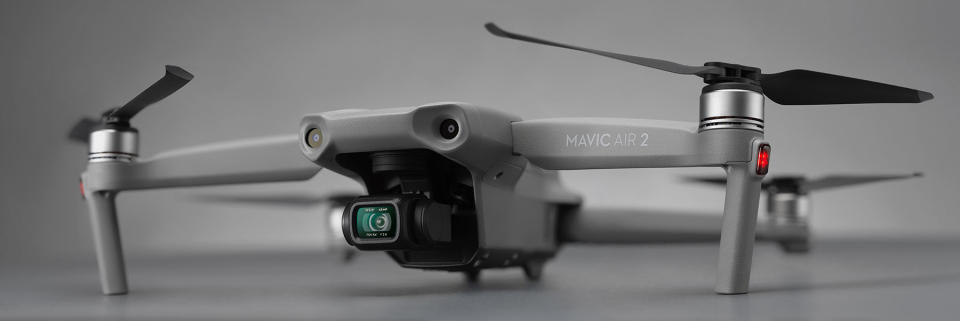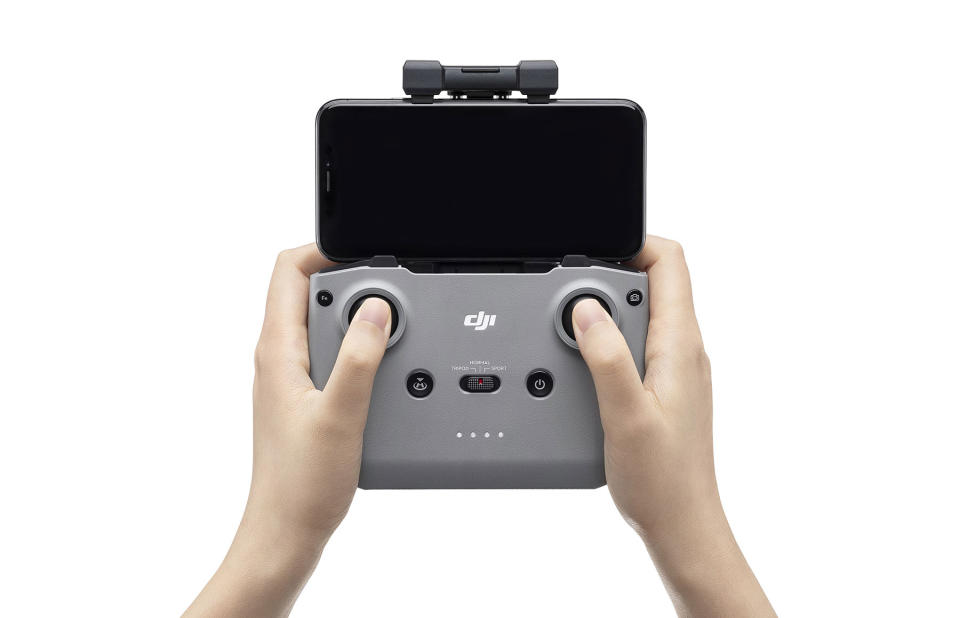DJI's Mavic Air 2 offers 34 minutes of flight time and 48-megapixel photos
The Mavic line up just got a lot more interesting.
If you happened across DJI’s website this week, you can’t have missed the prominent teaser for a new product — or maybe you saw the leak that basically gave the game away. Well, it’s finally official: say hello to the Mavic Air 2.
As the name suggests, it’s a sequel to the 2018’s Mavic Air — a drone I was very taken with. According to the company, the Mavic Air 2 isn’t a simple tune-up, it was redesigned from the ground up with a particular focus on the user experience and not just ramping up the specs. Though we’ll be the judge of that once we get our hands on it.
DJI might be focusing on how much easier the Mavic Air 2 is to fly, but to be fair, the specs definitely weren’t an afterthought. The first number to leap out at you might be the flight time, which DJI claims is a neck-aching 34 minutes — making the Mavic Air 2 the longest flying drone in the company’s lineup. To be clear, 34 minutes might not sound like much, but in the drone world, it’s an eternity. DJI says it was able to achieve this with new electronic speed controllers (ESC), new battery and overall design. Factor in that the Mavic Air 2 also weighs a little more than the original (570g versus 470g) and it’s clear the company has been busy with its R&D.
All that time in the air is fun, but all for naught if the camera isn’t up to scratch. Thankfully there are some solid upgrades here as well. The Mavic Air 2 now has a 1/2” Quad Bayer sensor (up from the original’s 1/2.3”) which still shoots 12-megapixel images, though there is a 48-megapixel mode too (it’s not clear if this is four images stitched together yet). As for video, you’ll be able to shoot in 4K at 60 fps (and 120 mbps) which bests even the Mavic 2, which tops out at 30 fps in 4K. Fans of HDR photos in the original Mavic Air will be pleased to know that you can now shoot video in high dynamic range also, along with a new 8K Hyperlapse mode.

Much of DJI’s camera functionality comes from the numerous auto-shot and “smart” modes. Again, there are some new goodies here. DJI was eager to talk up the new “scene recognition” feature which sounds like the trick we’ve seen on flagship phones where the camera knows (or, rather, guesses) where you’re shooting and automatically optimizes the settings for you. DJI claims the Mavic Air 2 can detect five scenes: sunset, blue skies, snow, grass and trees. That might not seem a lot, but up in the air that’s most things covered we guess. Along with the aforementioned HDR mode, there’s also “Hyperlight” for when shooting in low light conditions.
Videos will benefit from two layers of stabilization now. The 3-axis gimbal as before, with some additional help from EIS (which we hope/presume is optional). The Mavic Air 2’s FocusTrack feature offers some updated tracking modes: Spotlight 2.0, ActiveTrack 3.0 and Point of Interest 3.0. The former is a hand-me-down from the Inspire 2, which locks the camera onto a target, leaving you to simply fly the drone. Active Track we’ve seen before, but this time it should be more robust at following targets even when they go out of view temporarily. The updated Point of Interest mode claims to be better at recognizing different surfaces and more dynamic tracking — again, we’ll have to wait and see what that really means once we test it.
It’s not all about the fun stuff though, DJI has added some new safety features which might be less sexy, but certainly much appreciated. Most notably, the inclusion of ADS-B — which means the drone will be able to sense when something else (as in, actual planes etc.) is flying nearby. One last acronym for now, and that’s APAS 3.0 — something we saw introduced in the first Mavic Air. In short, it’s what allows the drone to fly around things that its sensors detect, and DJI claims it’s smoother and more fluid this time around. I’m very interested to see if it comes anywhere close to Skydio’s mind-bindingly good obstacle avoidance, something DJI hasn’t been able to compete with thus far in my opinion.

One last small, but important thing. It looks like DJI has updated the radio controller so that your phone will now perch on top, rather than clip in below. This might seem a minor detail, but as anyone with a larger phone will attest (especially if it’s in a case), clipping it into the old controller was clumsy at best. Let’s hope this new setup is simpler and more comfortable.
As rumored, the Mavic Air 2 will cost $799 at launch, but thanks to the pandemic, it’s only available in China right now, with a global rollout set for mid-May (around the 11th). DJI has a habit of semi-cannibalizing its own products, with new drones offering features even its flagships don’t have, and that seems to be the case here. Which is both great, and slightly confusing when it comes to deciding which one is for you. The premium Mavic Pro 2 series, with its superior camera, or the Mavic Air 2 with it’s longer flight time and new software tricks? Once we get it in for review, hopefully we can help you decide.

